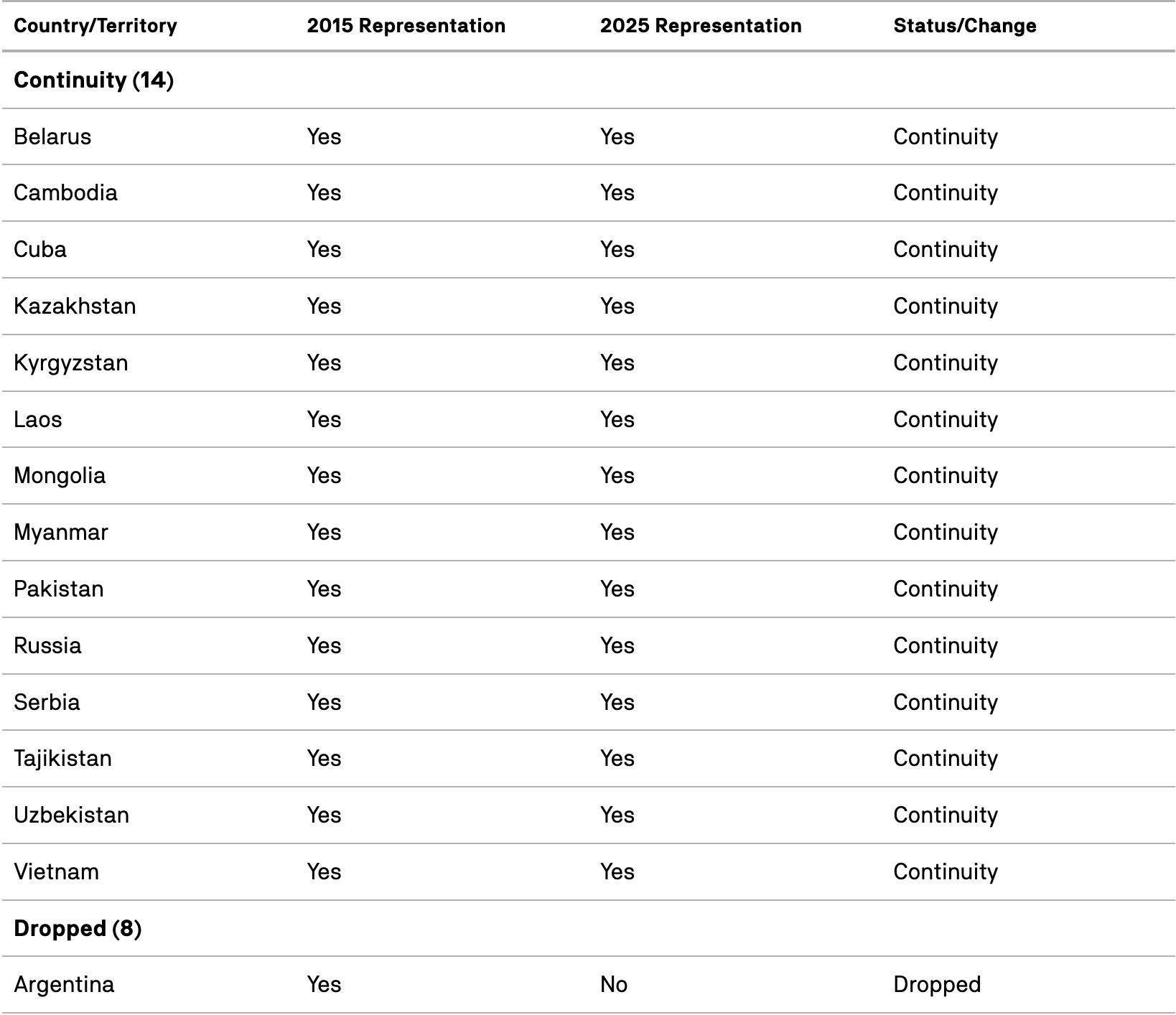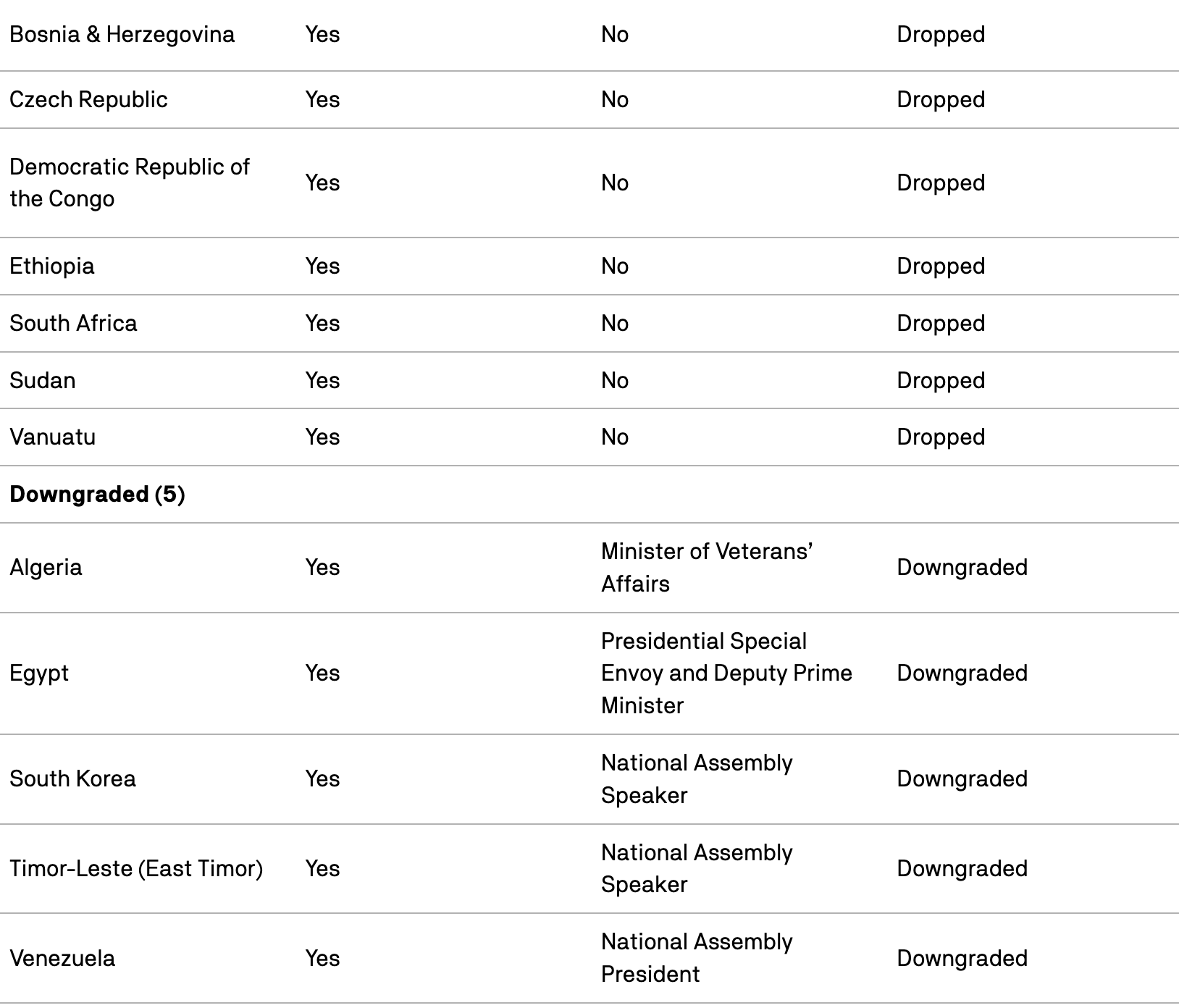A tale of two lists: How geopolitics shaped the attendance of China’s parade
September 3, 2025
On 3 September 2025, a large-scale parade will be held in Tiananmen Square to mark the 80th anniversary of what has been dubbed by Beijing the “Victory of the Chinese People’s War of Resistance against Japanese Aggression and the World Anti-Fascist War”.
The lead-up to the parade has been marked by domestic efforts to capture nationwide attention, as well as intense international scrutiny.
Highly symbolic in geopolitical terms, the list of foreign representatives, released by People’s Republic of China state media on 28 August, has been pored over by analysts and commentators seeking to discern the international landscape: who counts as the PRC’s friend, who falls within its sphere of influence and who is conspicuously absent?
Even more intriguing is the comparison with the 2015 parade guest list. Over the past decade, the escalating US-PRC rivalry has reshaped alliances and allegiances worldwide. How does this year’s roster of attendees reflect those shifts?
First, some background. In February 2014, Beijing declared 3 September a new national day to commemorate Japan’s defeat in 1945, with Japan having signed the first formal instrument of surrender on 2 September that year.
Although Japan’s full-scale invasion of China began in 1937, an earlier event looms large in the collective memory of the Chinese people: the Mukden Incident on 18 September 1931. Japanese officers staged an explosion on a section of Japanese-controlled railway track near the city of Mukden, blaming Chinese nationalists for the act as a pretext to commence the invasion and occupation of three northeastern provinces – territory Japan called “Manchuria”. In other words, China had already been at war long before World War II broke out in Europe. One of the darkest episodes of this war was the Nanjing Massacre, in which the Japanese military killed an estimated 100,000 to over 300,000 Chinese in the Nanjing area. In popular memory, it is described as the “Rape of Nanking: The Forgotten Holocaust of the World War II”.
Between 1931 and 1945, Japan’s wars of expansion drew in a broad array of opponents across the Asia-Pacific and beyond. Resistance came not only from China, which endured the longest conflict, but also from Australia, the US, the UK and Southeast and East Asian nations. These diverse participants, entering the struggle at different times, ultimately formed part of the wider Allied effort against Japan.
The PRC’s commemorative parade serves multiple purposes. According to a government spokesperson, it is intended to “remember history, honour the martyrs, cherish peace and create a better future”. Hu Xijin, former editor-in-chief of daily tabloid the Global Times, argues that the parade reminds the world that World War II was not only an European conflict, that the Asian theatre of the war deserves recognition as well. He also makes the claim that the event underscores an enduring perception that the Japanese Government has yet to convey genuine remorse to China and other Asia-Pacific neighbours. Outside the PRC, this year’s parade has been frequently described as a show of solidarity and defiance against the West, with Russia’s Vladimir Putin, North Korea’s Kim Jong-un and Iran’s Masoud Pezeshkian expected to flank Xi Jinping on the parade dais. A National University of Singapore academic characterised this year’s proceedings as an attempt by Xi to “showcase that he is very strong, that he is still powerful and well received in China”.
While the list of world leaders attending is important, the countries sending representatives instead of heads of state is equally telling. Perhaps the most revealing aspect of this comparison lies in what it suggests about shifting allegiances or which nations continue to hedge between the PRC and the US.
The first country to watch is, of course, Japan. In 2015, former Japanese prime minister Tomiichi Murayama, remembered for his forthright acknowledgement of Japan’s wartime actions, attended in a personal capacity. This year, former prime minister Yukio Hatoyama, who has spoken publicly about Japan’s wartime history since leaving office, will attend, also in a personal capacity.
Tokyo is not only absent from the event but has also actively lobbied other countries not to attend – an exercise that has drawn the ire of Beijing.
The nature of South Korea’s representation has also drawn the attention of observers. In 2015, president Park Geun-hye attended, whereas this year, National Assembly speaker Woo Won-shik will attend, a step down in rank from head of state-level representation. This downgrade is notable in the context of South Korea’s longstanding grievance with Japan over the issue of “comfort women”, stemming from the perception that Japan has never fully acknowledged or atoned for the suffering of Korean women and girls forced into sexual slavery by the Japanese military during World War II. This dispute remains deeply emotional and symbolic, tied to questions of historical justice, national dignity and the legacy of colonial rule, continuing to strain bilateral relations despite efforts at reconciliation. Still, Seoul’s decision to limit its participation at this year’s parade suggests that, for South Korea, present-day geopolitical considerations may outweigh the impulse to emphasise shared historical grievances with the PRC.
By contrast, North Korea’s representation by Kim Jong-un is an upgrade from 2015, when the country was represented by a Politburo member and secretary of the Central Committee of the Workers’ Party of Korea, Choe Ryong-hae.
In 2015, India was represented by then-minister of state for external affairs, V.K. Singh. This year, however, it will not send any representatives. That said, it is worth noting that by the time of the parade, Indian Prime Minister Narendra Modi would have just concluded a visit to the PRC for the first time in more than seven years to attend the Shanghai Co-operation Organisation summit.
US-PRC tensions have prompted a strategic realignment among many countries. Juxtaposing the two parade guest lists from 2015 and 2025 provides some insights. In addition to consolidating its close ties with Russia, Iran and North Korea — the group US Senator Mitch McConnell dubbed the “new axis of evil” in 2023 — the PRC appears to have maintained the support of several former Soviet states. At the same time, powerful Southeast Asian countries such as Malaysia and Indonesia seem willing to leverage the tension between the US and PRC to their own advantage, with leaders Anwar Ibrahim and Prabowo Subianto expected to be in attendance. Singapore’s Deputy Prime Minister Gan Kim Yong is also expected to attend.
In contrast, while Australia had previously sent a ministerial representative, with Abbott government minister for veteran affairs Michael Ronaldson attending in 2015, this year there will be no official representation. Instead, former foreign minister Bob Carr and former Labor premier of Victoria Daniel Andrews are reported to be attending in a personal capacity. If sending a high-level government representative rather than a head of state was previously a signal of hedging, it now seems clear that Australia has, more or less, reaffirmed its alliance with the US, as well as its stronger ties with Japan.
As with Australia, the heads of state from major Western countries are not attending – an absence already highlighted by international media. Representation is also lacking from the vast majority of Pacific Island nations. In 2015, Vanuatu was represented by its then-prime minister Sato Kilman, but this year no comparable figure, or indeed any official delegation, is present.
Of course, one should be careful not to over-interpret these two guest lists. Still, they provide a reasonably good indication of the lay of the land as far the PRC’s global standing is concerned.
Appendix 1. PRC Victory Day Parade: Country representation (head of state) 2015 vs. 2025



Republished from UTS Australia-China Relations Institute, August 29 2025
The views expressed in this article may or may not reflect those of Pearls and Irritations.

